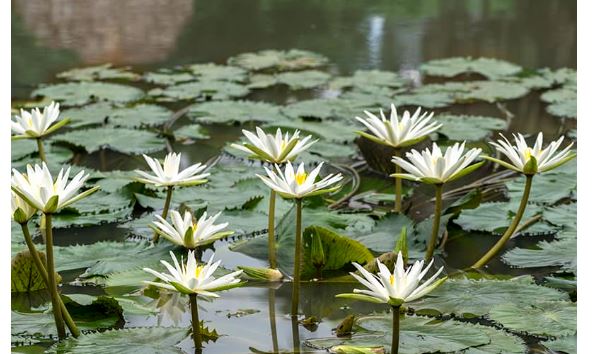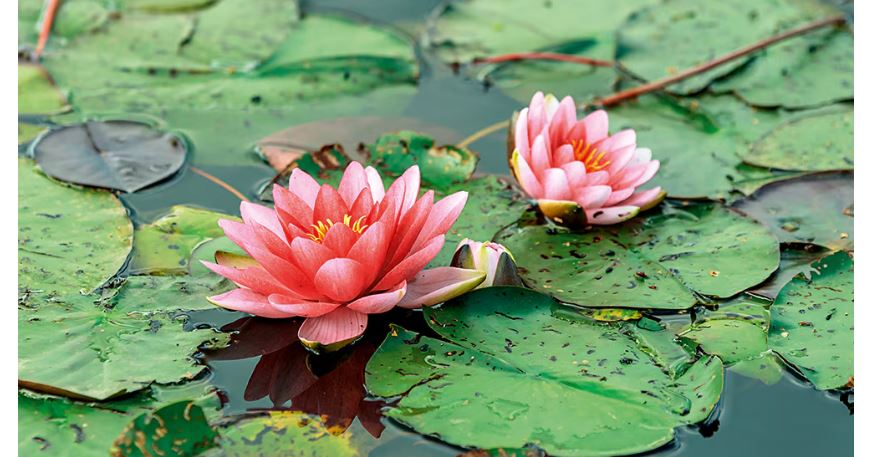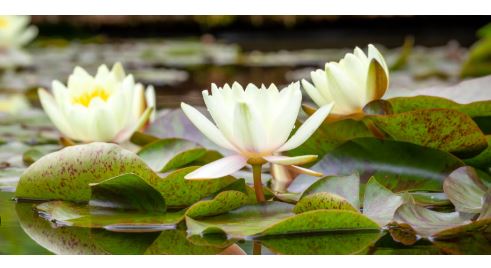
Plants that grow in water thrive in aquatic or semi-aquatic environments, with roots submerged or floating freely. These include true aquatics, marginal species, and houseplants adapted to hydroponics, found in ponds, aquariums, or indoor vases. They range from leafy floaters to rooted plants, enhancing water features or purifying ecosystems. Their ability to grow without soil makes them unique for decorative and functional uses.
Many of these plants prefer still or slow-moving water, with light needs varying from full sun to low indirect light. They grow in USDA zones 2–12, depending on species, with some tolerating cold and others requiring warmth. Submerged plants oxygenate water, while floaters provide shade, supporting aquatic life. Regular water changes or nutrient additions are key for indoor setups.
Floating plants often have rosette-like leaves or feathery foliage, absorbing nutrients directly from water. They’re ideal for ponds or aquariums, reducing algae by competing for nutrients. Some can be invasive, requiring control to prevent clogging waterways. Their rapid growth makes them valuable for natural filtration systems.

Marginal plants grow with roots in shallow water or wet soil, often featuring upright leaves or spikes. Planted pondside or in submerged pots, they stabilize banks and attract pollinators. Many are hardy, thriving in temperate climates, but some need protection from frost. Their structural beauty enhances water gardens.
Houseplants adapted to water, like trailing vines or leafy perennials, grow from cuttings in vases. They purify indoor air, require minimal care, and suit low-light spaces. Clean water and occasional nutrients prevent rot, while their lush foliage adds elegance to homes. Propagation is simple, making them popular for beginners.
Ecologically, these plants support biodiversity by providing habitat for fish, insects, and birds. Some are edible or medicinal, with cultural significance in cuisines or traditions. Their versatility, from ornamental to practical roles, makes them essential in water-based gardening, though invasiveness demands careful selection.

Amazing Aquatic Flowers
Water Lily (Nymphaea spp.)
Water lilies produce iconic, floating flowers with three petals and three sepals, in colors like white, pink, yellow, or red, atop round, waxy leaves (lily pads). Native to temperate and tropical regions, they grow in full sun and still water 6–18 inches deep (USDA zones 4–11). Planted in submerged containers, their blooms attract pollinators and provide shade for aquatic life, making them staples in water gardens.
Lotus (Nelumbo nucifera)
Lotus plants feature large, emergent flowers with multiple petals, often pink or white, rising above broad, circular leaves. Native to Asia, they thrive in full sun and muddy, submerged containers in 12–24 inches of water (zones 4–10). Their dramatic blooms and edible seeds or roots are culturally significant, attracting bees and enhancing pond aesthetics, though they require warm conditions.
Pothos (Epipremnum aureum)
Pothos, or devil’s ivy, has heart-shaped, variegated green and yellow leaves on trailing vines. Native to Southeast Asia, it grows in water with roots submerged in vases, thriving in low to bright indirect light (zones 10–12). Ideal for indoor hydroponics, it’s low-maintenance, air-purifying, and propagates easily from cuttings, but requires regular water changes to prevent algae.
Spider Plant (Chlorophytum comosum)
Spider plants produce long, arching green leaves with white stripes and small plantlets (pups) on dangling stems. Native to South Africa, they grow in water with plantlets rooted in glass containers, preferring bright indirect light (zones 9–11). Easy to propagate, they’re perfect for indoor displays, air purification, and sharing, though leaves may rot if submerged.
Peace Lily (Spathiphyllum spp.)
Peace lilies feature glossy, dark green leaves and white, hood-like flowers (spathes) on slender stalks. Native to Central America, they can grow in water with roots submerged, thriving in bright filtered light (zones 11–12). Used in vases indoors, they purify air and add elegance, but need weekly water changes and occasional liquid fertilizer to avoid nutrient deficiency.
Lucky Bamboo (Dracaena sanderiana)
Lucky bamboo, not true bamboo, has slender, green stalks often twisted into spirals, with small leaves. Native to Africa, it grows in water with pebbles for support, in low to medium indirect light (zones 10–11). A popular indoor plant symbolizing good fortune, it requires clean, non-chlorinated water and minimal care, though algae can form in clear containers.
Philodendron (Philodendron hederaceum)
Heartleaf philodendron has glossy, heart-shaped green leaves on trailing vines. Native to Central America, it thrives in water with stem cuttings rooted in vases, in low to bright indirect light (zones 11–12). A beginner-friendly hydroponic plant, it grows quickly, purifies air, and needs water changes every 3–4 days to prevent bacterial growth.
Chinese Evergreen (Aglaonema spp.)
Chinese evergreens have lance-shaped, variegated leaves in green, pink, or silver patterns. Native to Asia, they grow in water with stems submerged, tolerating low light (zones 10–12). Ideal for indoor hydroponics, they’re hardy, air-purifying, and stylish, but require regular water changes and occasional hydroponic nutrients to maintain vibrant foliage.
Arrowhead Plant (Syngonium podophyllum)
Arrowhead plants display arrow-shaped leaves in green, white, or pink variegation on vining stems. Native to South America, they grow in water with cuttings rooted in jars, preferring bright indirect light (zones 10–12). Their compact, bushy habit suits indoor displays, but water must be changed weekly to prevent rot, and nodes should stay submerged.
Water Hyacinth (Eichhornia crassipes)
Water hyacinth is a free-floating plant with dark green, rosette-like leaves and vibrant purple flowers. Native to South America, it thrives in full sun and nutrient-rich water (zones 9–11). Used in ponds, it purifies water and attracts pollinators, but its fast growth can be invasive, requiring regular removal to prevent overcrowding.
Water Lettuce (Pistia stratiotes)
Water lettuce forms floating rosettes of light green, velvety leaves with dangling roots. Native to tropical regions, it grows in partial to full sun in still water (zones 9–11). Ideal for ponds or aquariums, it shades aquatic life and reduces algae, but can be invasive, needing control to avoid clogging waterways.
Papyrus (Cyperus papyrus)
Papyrus has tall, green stems topped with feathery, umbrella-like foliage. Native to Africa, it grows in full sun, submerged or pondside in wet soil (zones 8–10). Its tropical look enhances water gardens, and historically, it was used for paper. It attracts birds and requires consistent moisture, tolerating up to 6 inches of water depth.
Cattail (Typha latifolia)
Cattails produce tall, grassy leaves and brown, fuzzy flower spikes. Native to North America, they grow in full sun, submerged or pondside in up to 12 inches of water (zones 3–11). Used in water gardens, they stabilize soil and provide habitat for wildlife, but native species should be chosen to avoid invasiveness.
Cardinal Flower (Lobelia cardinalis)
Cardinal flowers bear spikes of bright red, tubular blooms above lance-shaped leaves. Native to North America, they thrive pondside in partial shade and moist soil (zones 3–9), tolerating brief flooding. Their late-summer flowers attract hummingbirds, making them ideal for water garden edges, but soil must stay consistently wet.
Watercress (Nasturtium officinale)
Watercress has small, round green leaves on creeping stems, with a peppery flavor. Native to Europe, it grows in shallow, slow-moving water or wet soil in partial sun (zones 3–11). A nutritious edible, it’s used in salads and thrives in aquaponics, but requires clean, oxygenated water to prevent rot.
Sweet Flag (Acorus calamus)
Sweet flag features bright green, sword-like leaves with a sweet scent when crushed. Native to Europe and Asia, it grows in full sun to partial shade, submerged or pondside in up to 6 inches of water (zones 4–10). Its variegated forms add texture to water gardens, attracting insects, and it tolerates boggy conditions well.
Pickerel Rush (Pontederia cordata)
Pickerel rush produces heart-shaped leaves and spikes of purple-blue flowers. Native to North America, it grows in full sun, submerged in 3–12 inches of water (zones 3–10). Its summer blooms attract bees and butterflies, making it a striking pond plant, though it requires space to spread via rhizomes.
Anubias (Anubias barteri)
Anubias is a slow-growing aquatic plant with dark green, leathery, oval leaves on short stems, popular in aquariums. Native to Africa, it thrives in low to medium light, fully submerged with roots anchored to rocks or driftwood (USDA zones 10–12). Its hardy nature suits beginner aquarists, providing shelter for fish, though it requires clean water and occasional liquid fertilizer to prevent algae growth.
Java Fern (Microsorum pteropus)
Java fern features long, lance-shaped green leaves with a textured, wavy appearance, ideal for aquariums. Native to Southeast Asia, it grows fully submerged, attached to wood or rocks in low to moderate light (zones 10–12). Its rhizomes must stay exposed to avoid rot, and it propagates via plantlets, offering low-maintenance cover for fish while enhancing tank aesthetics.
Amazon Sword (Echinodorus amazonicus)
Amazon sword has broad, bright green, sword-shaped leaves forming a rosette, a staple in aquariums. Native to South America, it grows fully submerged in moderate to high light with nutrient-rich substrate (zones 10–12). Its tall leaves provide hiding spots for fish, but it needs CO2 supplementation and regular fertilization for robust growth in water-only systems.
Hornwort (Ceratophyllum demersum)
Hornwort is a free-floating aquatic plant with feathery, needle-like green leaves in whorls along brittle stems. Native globally, it thrives in full sun to shade, fully submerged in aquariums or ponds (zones 5–11). It oxygenates water, reduces algae, and shelters fish, but its rapid growth requires occasional trimming to prevent overcrowding.
Duckweed (Lemna minor)
Duckweed consists of tiny, oval green fronds floating on water surfaces, often carpeting ponds or aquariums. Native worldwide, it grows in full sun to partial shade in nutrient-rich water (zones 4–10). It absorbs excess nutrients, aiding water purification, but can be invasive, requiring regular removal. Duckweed is also used as fish or livestock feed.
Water Sprite (Ceratopteris thalictroides)
Water sprite has finely divided, light green leaves that can float or grow submerged in aquariums. Native to tropical regions, it thrives in moderate to high light and warm water (zones 10–12). Its lacy foliage provides cover for fish fry, and it propagates easily, but it needs nutrient-rich water and occasional pruning to maintain shape.
Java Moss (Vesicularia dubyana)
Java moss forms dense, green, carpet-like growth with tiny leaves, perfect for aquariums or terrariums. Native to Southeast Asia, it grows submerged, attached to surfaces in low to medium light (zones 10–12). It’s low-maintenance, offering spawning sites for fish, but requires clean water and occasional thinning to prevent debris buildup.
Water Wisteria (Hygrophila difformis)
Water wisteria has bright green, feathery leaves that vary in shape when submerged or emersed, popular in aquariums. Native to South Asia, it grows in moderate to high light with nutrient-rich water (zones 10–12). Its fast growth absorbs nitrates, benefiting water quality, but it needs regular trimming and fertilization to prevent legginess.
Yellow Flag Iris (Iris pseudacorus)
Yellow flag iris produces vibrant yellow, three-petaled flowers above sword-like green leaves, thriving pondside or submerged in up to 6 inches of water. Native to Europe, it grows in full sun and wet soil (zones 5–9). Its summer blooms attract bees, but it can be invasive, requiring containment in water gardens to prevent spreading.
Marsh Marigold (Caltha palustris)
Marsh marigold bears cheerful, buttercup-like yellow flowers atop glossy, heart-shaped leaves. Native to North America and Europe, it grows pondside or in shallow water in full sun to partial shade (zones 3–7). Blooming in spring, it attracts pollinators and adds color to bog gardens, needing consistently moist conditions.
Water Mint (Mentha aquatica)
Water mint has aromatic, serrated green leaves and small, purple flower clusters, growing in shallow water or wet soil. Native to Europe, it thrives in full sun to partial shade (zones 5–9). Its minty scent repels pests, and leaves are used in teas, but it can spread aggressively, requiring containment in ponds or aquaponics.
Taro (Colocasia esculenta)
Taro features large, heart-shaped green leaves on thick stalks, often grown in shallow water for ornamental or edible roots. Native to Asia, it thrives in full sun and wet soil or up to 6 inches of water (zones 8–11). Used in tropical water gardens, it needs warm conditions and rich soil, attracting minimal pests.
Water Poppy (Hydrocleys nymphoides)
Water poppy produces floating, heart-shaped leaves and bright yellow, poppy-like flowers with three petals. Native to South America, it grows in full sun and 6–12 inches of water (zones 9–11). Its summer blooms attract bees, enhancing pond beauty, but it requires warm water and occasional division to prevent overcrowding.
Mosaic Plant (Ludwigia sedioides)
Mosaic plant forms rosettes of red and green, diamond-shaped leaves floating in a star-like pattern, ideal for ponds. Native to South America, it thrives in full sun and shallow, warm water (zones 9–11). Its unique foliage adds texture to water gardens, but it’s sensitive to cold, often grown as an annual in cooler climates.
Blue Water Lily (Nymphaea caerulea)
Blue water lily, distinct from other water lilies, bears striking blue, star-shaped flowers with three petals and three sepals atop floating pads. Native to Africa, it grows in full sun and 12–24 inches of water (zones 10–12). Its fragrant blooms attract pollinators, ideal for tropical ponds, requiring warm temperatures and submerged pots.
Water Hawthorn (Aponogeton distachyos)
Water hawthorn has floating, oval leaves and fragrant, white flowers with three petals, blooming in cooler seasons. Native to South Africa, it grows in full sun to partial shade and 6–24 inches of water (zones 8–11). Its unique winter blooms enhance ponds, attracting insects, but it goes dormant in summer heat.
Floating Heart (Nymphoides peltata)
Floating heart produces small, yellow, fringed flowers with three petals above heart-shaped, floating leaves. Native to Europe and Asia, it thrives in full sun and 6–18 inches of water (zones 6–10). Its delicate blooms attract bees, perfect for ponds, but it can spread rapidly, needing monitoring to avoid invasiveness.
Eelgrass (Vallisneria spiralis)
Eelgrass, also known as tape grass, features long, ribbon-like green leaves that grow fully submerged, forming underwater meadows in aquariums or ponds. Native to Europe and Asia, it thrives in moderate to high light and nutrient-rich water (USDA zones 5–11). Its oxygenating roots stabilize substrates and provide fish shelter, but it requires clean water and occasional trimming to control growth.
Parrot’s Feather (Myriophyllum aquaticum)
Parrot’s feather has feathery, bright green foliage that grows submerged or emergent in shallow water, creating a lush, cascading effect. Native to South America, it thrives in full sun and up to 6 inches of water (zones 6–11). Used in ponds for ornamentation and water filtration, it attracts insects but can be invasive, requiring regular thinning to prevent clogging waterways.
Water Chestnut (Trapa natans)
Water chestnut produces floating rosettes of triangular, toothed green leaves and small, white flowers, with edible, nut-like seeds. Native to Eurasia, it grows in full sun and shallow, nutrient-rich water (zones 8–11). Its seeds are harvested for culinary use, and it enhances pond aesthetics, but its invasive potential demands careful management to avoid overcrowding.
Bog Arum (Calla palustris)
Bog arum features glossy, heart-shaped leaves and white, hood-like flowers (spathes) on short stalks, growing pondside or in shallow water. Native to North America and Europe, it thrives in partial shade and wet soil or up to 3 inches of water (zones 2–6). Its spring blooms attract pollinators, ideal for bog gardens, but its toxic nature requires caution around pets.